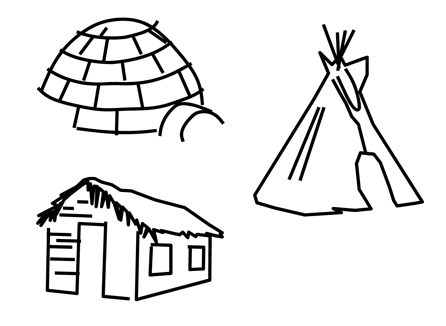
Every living thing builds shelter. Birds build nests. Bees build hives. Rabbits build warrens. Our earth is our shelter. Ever since the cave dwellers, people have sought to protect themselves from real and imagined enemies: other animals, other people and the weather. People need protection from the wind, the rain, the heat, the cold and the snow. People build shelters in every place on the earth: mountaintops, deserts, seasides and underground. In a shelter, people can rest, sleep and store supplies. Most people and animals make shelters from materials that they can easily find like leaves, grass, twigs, mud, rocks, animal skins and even ice. Shelters in hot climates use thick walls and small openings for shade and protection. They even use wind scoops or atriums to move air for cooling. Shelters in cold climates use thick walls too, and sloped roofs to shed the rain and snow. Both early shelters and shelters today can be mobile so that people can move to water, food, work, and safety.
Activity 1 – Research World Shelters

What kind of places do people live in around the world? Think about the different biomes. Look into housing types in each of the 7 climatic areas. Make a visual chart that lists the biomes [bi-ohms], a major regional or global natural community, such as a grassland or desert, characterized chiefly by the dominant forms of plant life and the prevailing climate, weather temperatures, amount of precipitation and building materials. Copy or draw a picture of a typical shelter or house.
Activity 2 – Give Me Shelter!

What would you do if you were homeless? Think about the weather where you live. Is it hot, cold, wet or dry? Do you need insulation or ventilation or both? What materials can you easily find? Think about natural materials like mud, rocks, branches, leaves and grasses. Think about recyclable paper, cardboard, tin, plastic, and rubber. Build one shelter from natural materials and one shelter from recyclable materials. Build your shelter large enough to crawl into so you can sit and sleep. Invite someone to visit your shelter. Evaluate your shelter based on the following points:
- Was it easy to find the materials?
- Was the material easy to work with?
- Did the materials stay together?
- Does your shelter keep out water?
- Does your shelter keep you warm/cool?
- Is your shelter comfortable?
Activity 3 – world shelters

How many people in the world are without shelter? What can we do to help? After air (to breathe ), water (to drink) and food (to eat) we need shelter to live. All of nature’s animals create habitats to raise their young, and to survive. Humans need shelters, too. Many people on earth are without shelters due to natural disasters like earth quakes, tornadoes, tsunamis, or hurricanes. Shelters for these circumstances must be light, easy to transport and put together. Other people are left homeless in times of conflict or war. These people, too, need adequate shelter to heal and reestablish productive lives. Finally, many of the world’s population live in extreme poverty. Helping to provide shelter for individuals less fortunate is a compassionate contribution to civilization. People with shelter (and clean, air, water and food) can begin to contribute to the well being of their own communities. Research temporary shelters such as domes, tents and shells. Compare the weight, cost and ease of construction for each. Can you think of another type of shelter that you could contribute? What materials could you reuse? How would they be joined together? Make sketches in your journal. Create shelters that are quick and easy to construct! Be a citizen activist! Find a way to help others.
Activity 4 – Log Cabins

Early settlers built log cabins as their first homes. People cut down trees in the woods and laid the logs perpendicular to each other to form rectangles. The ends of the tree logs were notched to stack tightly and form strong corners. The air holes were sealed with mud to keep the cold air out. Some log cabin roofs were thatched or covered with sod. Watch Billy build a log cabin to see how a cabin is framed and finished. Building log cabins was very hard work. Draw an example of a log cabin. What kind of shelter could you build today?
Review
- Animals build shelters.
- Shelters can be built almost anywhere.
- Early shelters were built with local materials.
- Shelters protect people from temperature.
- Insects build shelter.
Explore
- Build an Igloo
- Catahoyuk House
- Emergency Shelter
- Gimme Shelter
- Göreme National Park Cappadocia
- Hurricane Katrina Cottage, New Orleans
- Kithaus
- Madhousers
- Malcolm Wells Underground Architecture
- Mobile Shelter
- New Orleans Prototypes
- Oldest Shelters Found
- Regional Architecture
- Rock Shelters
- Safety in the Wild
- Shelter Design, Guggenheim Competitiom
- Shelter for Life
- Shelter Systems
- TEDed How an Igloo keeps you warm
- TEDtokyo Shiguru Ban Emergency Paper Shelters
- Teepees, Longhouses & Pueblo Homes
- The Cave of Chauvet Pont D'arc
- The Primitive Hut Marc Antoine Laugier
- The School of Architecture Student Design Shelters
- Tiny Houses
- Tree Hotel
- Video Celtic Iron Age Village of Tiny Houses
- Video How to Build an Igloo
- Video Lakota Teepee Trilogy
- Video Mesa Verde World Heritage Site
- Video Quick House
- World Shelter
- World Shelters International Relief and Development
- You have never seen a yurt like this!



















































